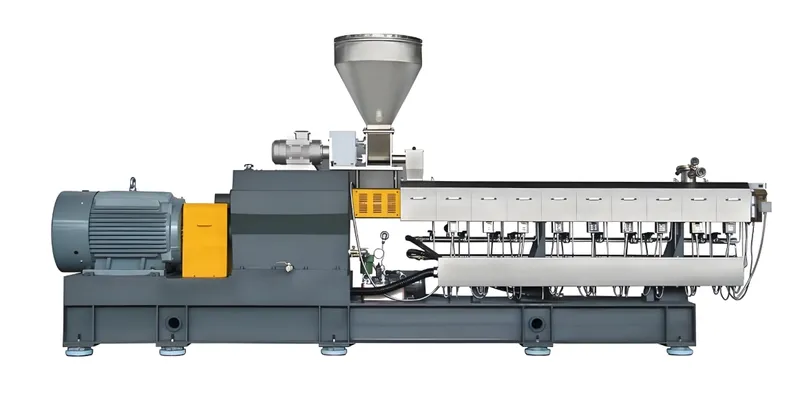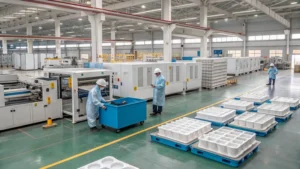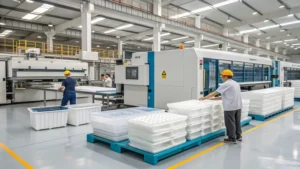
Extruders are vital machines across industries like plastics, food, and pharmaceuticals, shaping materials by forcing them through a die. The two primary types—single-screw and twin-screw extruders1—differ significantly in design and function. Single-screw extruders feature one screw within a heated barrel, while twin-screw extruders employ two intermeshing screws. The choice between them hinges on application-specific needs.
Twin-screw extruders offer superior mixing and material handling capabilities2 compared to single-screw extruders3, making them ideal for complex and high-value applications.
This article explores the advantages of twin-screw extruders, providing insights into their technical benefits, applications, and considerations for choosing the right extruder for your needs.
Twin-screw extruders provide better mixing than single-screw extruders.True
The intermeshing screws create a more intensive mixing action, ensuring uniform dispersion of additives and fillers.
Single-screw extruders are sufficient for all types of extrusion processes.False
While suitable for simple tasks, they lack the mixing efficiency and material versatility of twin-screw extruders for complex applications.
- 1. What Are the Basic Differences Between Single-Screw and Twin-Screw Extruders?
- 2. What Are the Key Applications of Twin-Screw Extruders?
- 3. What Are the Technical Advantages of Twin-Screw Extruders?
- 4. What Are the Downsides of Twin-Screw Extruders?
- 5. How to Choose Between Single-Screw and Twin-Screw Extruders?
- 6. Conclusion
What Are the Basic Differences Between Single-Screw and Twin-Screw Extruders?
The fundamental differences between single-screw and twin-screw extruders lie in their design and operational capabilities, influencing their suitability for various tasks.

Single-screw extruders use one screw for basic extrusion tasks, while twin-screw extruders leverage two intermeshing screws for enhanced mixing and material handling, excelling in complex processes.
| Feature | Single-Screw Extruder | Twin-Screw Extruder |
|---|---|---|
| Number of Screws | One | Two (co-rotating or counter-rotating) |
| Mixing Capability | Limited; relies on screw design | Excellent; intermeshing screws enhance mixing |
| Material Handling | Best for simple, granular materials | Versatile; handles powders, pastes, heat-sensitive materials |
| Cost | Lower initial and maintenance costs | Higher initial and maintenance costs |
| Complexity | Simpler design, easier to operate | More complex, requires technical expertise |
| Applications | Standard tasks (e.g., pipes, profiles) | Complex mixing, compounding, reactive extrusion |
Single-Screw Extruder
A single-screw extruder uses one rotating screw in a heated barrel to melt and convey materials. It’s cost-effective and straightforward, ideal for basic tasks like producing pipes or profiles from granular materials.
Twin-Screw Extruder
Twin-screw extruders feature two intermeshing screws, enhancing mixing and material handling. This design suits complex applications, offering greater control and versatility, though it demands higher investment and expertise.
Twin-screw extruders are more versatile than single-screw extruders.True
The dual-screw design accommodates a wider range of materials and processes, including those needing intensive mixing.
Single-screw extruders are always less efficient than twin-screw extruders.False
For simple tasks, single-screw extruders can be more efficient and cost-effective.
What Are the Key Applications of Twin-Screw Extruders?
Twin-screw extruders shine in industries requiring precise blending and handling of complex materials.
Twin-screw extruders are preferred in food processing4, engineering plastics5, medical materials, and foam extrusion for their superior mixing and material handling capabilities.

Food Processing
In food production, twin-screw extruders create high-quality snacks, cereals, and pet food. Their uniform mixing ensures consistent texture and flavor, critical for consumer appeal.
Foam Extrusion
They enable lightweight, insulated foam products for packaging and construction, offering precise control over foam structure.

Engineering Plastics
For compounding plastics with additives like glass fibers or flame retardants, twin-screw extruders deliver specific properties needed in automotive, aerospace, and electronics applications.
Medical Materials
Twin-screw extruders process heat-sensitive materials for medical products like catheters and implants, maintaining quality through gentle yet effective mixing.
Twin-screw extruders are crucial for producing high-quality food products.True
Their superior mixing ensures uniform ingredient distribution, enhancing product consistency.
Single-screw extruders can handle all materials used in medical applications.False
They lack the control and gentleness needed for heat-sensitive medical materials.
What Are the Technical Advantages of Twin-Screw Extruders?
The dual-screw design provides several technical edges over single-screw extruders.
Twin-screw extruders offer enhanced mixing, higher throughput6, and greater material versatility7, making them ideal for complex extrusion processes.

Enhanced Mixing
Intermeshing screws create a self-wiping action, ensuring thorough mixing and uniform additive dispersion—vital for high-performance materials.
Higher Throughput
Efficient conveying and mixing allow twin-screw extruders to process materials faster, boosting production efficiency.

Material Versatility
They handle diverse materials—high-viscosity polymers, powders, and heat-sensitive compounds—preserving properties through gentle processing.
Better Control
Adjustable screw configurations and speeds provide precise process control, optimizing product quality.
Twin-screw extruders consume less energy than single-screw extruders.False
While efficient in throughput, they may use more energy per unit output for some applications.
The dual-screw design allows for better temperature control during extrusion.True
Intermeshing screws distribute heat evenly, reducing overheating risks.
What Are the Downsides of Twin-Screw Extruders?
Despite their benefits, twin-screw extruders have drawbacks to consider.
Twin-screw extruders are more expensive and complex than single-screw extruders, requiring higher investment and technical expertise.

Higher Costs
Initial costs are about twice that of single-screw extruders, with maintenance expenses also elevated due to complex machinery.
Complexity and Technical Expertise
Operation and maintenance demand skilled personnel, increasing training costs and limiting operator availability.
Energy Consumption
For simpler tasks, twin-screw extruders may consume more energy per unit output than single-screw alternatives.
Twin-screw extruders are always the best choice for extrusion processes.False
For basic tasks with simple materials, single-screw extruders may suffice and be more cost-effective.
The higher cost of twin-screw extruders is justified by their performance in complex applications.True
Their capabilities improve quality and efficiency, offsetting initial costs.
How to Choose Between Single-Screw and Twin-Screw Extruders?
Selecting the right extruder depends on your application, budget, and resources.
Choose a twin-screw extruder for complex materials and high mixing needs; opt for a single-screw extruder for simple tasks and cost-sensitive projects.

Decision-Making Checklist
-
Material Complexity: Twin-screw for complex materials; single-screw for simple ones.
-
Production Volume: Twin-screw for high-volume, consistent quality; single-screw for smaller runs.
-
Budget: Single-screw for cost savings; twin-screw if performance justifies expense.
-
Technical Resources: Twin-screw requires skilled operators.
Simple Decision Tree
-
Need complex materials or high mixing?
- Yes → Twin-screw
- No → Single-screw
-
High production volume with quality needs?
- Yes → Twin-screw
- No → Single-screw
-
Budget constraints?
- Yes → Single-screw
- No → Twin-screw if other factors align
Twin-screw extruders are suitable for small-scale production.False
They’re optimized for large-scale production due to throughput and efficiency.
Single-screw extruders are easier to operate and maintain.True
Their simpler design requires less expertise.
Conclusion
Twin-screw extruders excel over single-screw models in mixing efficiency, material versatility, and production capacity, making them essential for complex applications in food, plastics, and medical fields. However, their higher costs and complexity require careful evaluation of your needs.
-
Explore the benefits of twin-screw extruders to understand why they excel in complex applications and material handling. ↩
-
Discover best practices for enhancing material handling in extrusion processes, crucial for efficiency and quality. ↩
-
Learn about single-screw extruders to see how they compare to twin-screw models and their specific use cases. ↩
-
Learn how twin-screw extruders improve food production quality and consistency, crucial for consumer satisfaction. ↩
-
Discover how twin-screw extruders enhance the properties of engineering plastics for various applications. ↩
-
Discover the key factors that enable twin-screw extruders to achieve higher throughput, boosting production efficiency significantly. ↩
-
Learn how material versatility in twin-screw extruders enhances their application across various industries, ensuring optimal performance. ↩








